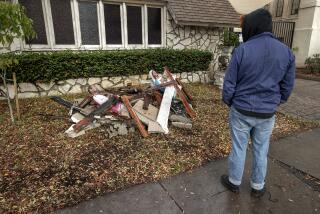Mendocino Statue Remains a Timeless Mystery
MENDOCINO, Calif. — For more than a century at this time of year, many have wondered if the mysterious statue on the top of the old Masonic Hall in this quaint coastal town has something to do with the dawning of a new year.
The large statue carved out of a solid block of redwood shows what appears to be a bearded Father Time with wings and a sickle, standing at the back of a maiden patiently braiding her hair.
Standing behind a book open on a pedestal, the maiden holds an acacia branch in her right hand, an urn in her left hand. By her side is an hourglass and in front of her is a broken column.
The tableau, it turns out, has nothing directly to do with New Year’s. Rather, its figures are engaged in rituals known only to Masons.
For everyone else, the scene on the roof remains the same silent enigma that it has been since its creation in 1872 not long after the Masonic Hall was erected by the 70 seafarers, loggers and ranchers who founded the lodge. The top floor is still the lodge headquarters. The bottom floor, since 1977, when the Masons sold the building, is a branch of the Savings Bank of Mendocino.
“Hardly a day passes that someone doesn’t come into the bank and ask the meaning of the statue,” said Erich Schmid, 43, vice president and manager of the bank branch. “Some days several people come in and ask for an explanation. I tell them it means what you see.”
Schmid knows what the statue means but he won’t say. He also happens to be the treasurer of the lodge. “It’s Greek to everyone except a Mason. Some ask, ‘Is Father Time strangling that woman?’ ” laughed the banker.
Wilbur Wade, 60, retired state forest ranger and master of the lodge, says he cannot reveal the meaning of the mythical figures. It depicts a part of the confidential Masonic ritual, he said.
Fran Lewis, 65, the assistant grand secretary of the Grand Masonic Lodge of California in San Francisco, explains that there is a special meaning to each part of the statue.
“But I can’t tell you the story behind each item,” he said. “All Masons know it. They learn the story when they take their third degree, the final step to becoming a Mason. The meaning of what is depicted by the statue isn’t written. It is passed along word of mouth, one Mason to another.”
Lewis added that what he can say is that all parts of the statue together mean “time, patience and perseverance will accomplish all things.
“That statue really should not be there,” he said. “It should never have been done. Technically, according to our beliefs, it is something that should not be publicly displayed.”
Duane (Buck) Killion, 59, a retired CHP officer and past master of the Mendocino Masonic Lodge, said Masons from all over America and many foreign countries come to the isolated small town just to see the statue. “All Masons know it’s here,” Killion said.
The statue was hand-carved by the lodge’s first master, Erick Albertson. He was 27 in 1865 when he started carving it in his spare time. He worked at the local lumber mill. He carved the statue in a cabin on the beach and worked at night by candlelight. It took him seven years to finish it. Shortly after he finished it he died.
Albertson also carved fluted columns, arches, ceiling decorations and other artistic renderings inside the building, all symbolic of the Masonic order.
The Father Time statue is the best-known landmark in Mendocino, located on a spectacular headland, a town of 1,000 population founded in 1852 by several people who migrated to California from the state of Maine.
More to Read
Sign up for Essential California
The most important California stories and recommendations in your inbox every morning.
You may occasionally receive promotional content from the Los Angeles Times.








